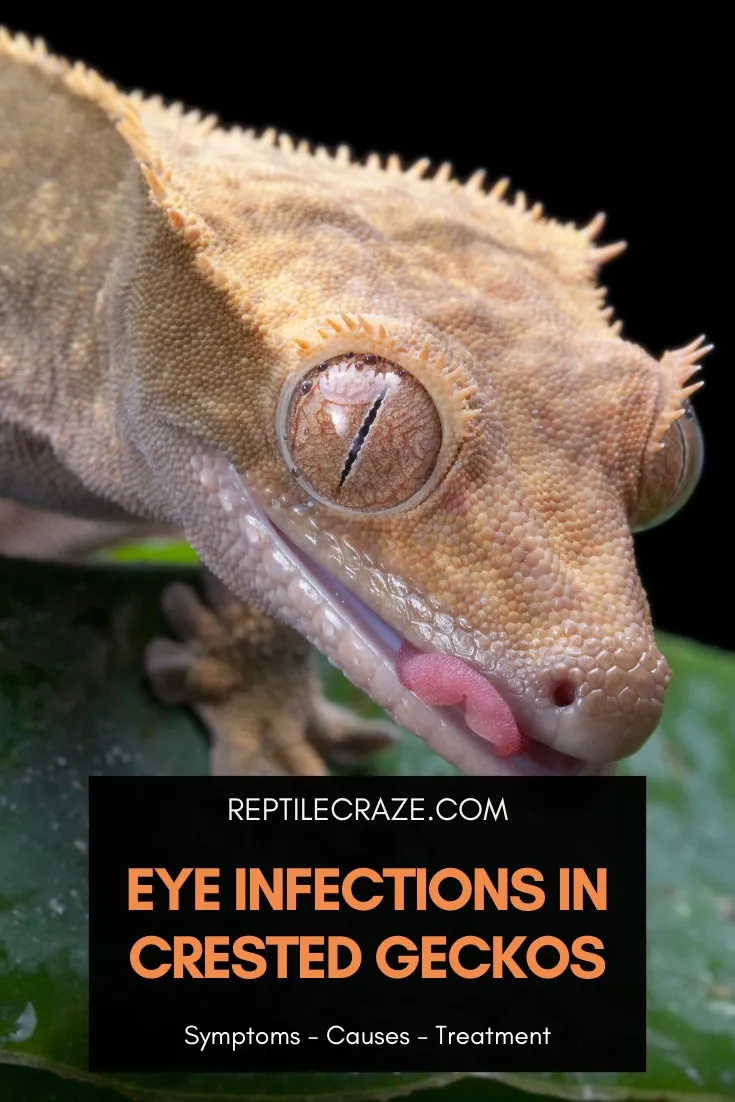
If you’re reading this article, you’ve probably noticed something weird happening with your crested gecko’s eyes, and are wondering whether this is an infection.
Eye infections in crested geckos can be viral, bacterial, or fungal. The infected eyes may look swollen, cloudy, opaque, or injured. Your gecko might change its eye-licking behavior or rub its eyes or head onto surfaces. These infections are often caused by and can lead to other diseases.
If you want to learn more about how an infected eye looks precisely in a crested gecko, keep reading, as we provide essential details about the topic.
Table of Contents
Eye Infections In Crested Gecko: Overview
Crested geckos, like other reptiles, can develop viral, bacterial, and fungal eye infections. These infections do not just happen. They can be caused by any bacteria or viruses in your reptile’s
While sometimes eye infections are linked to poor
Besides, they may appear as a secondary condition of other diseases or be caused by trauma, malnutrition, or retained spectacle.
Discussing eye infections only is not enough because it’s essential to understand where they come from. If the source issue isn’t fixed, the infection may come back.
Moreover, it’s of the essence to learn what eye infections can lead to if left untreated.
As such, we’ll first discuss some symptoms and complications of eye infections in crested geckos, then move on to some illnesses that can lead to eye infections as secondary health conditions.
At the end of the article, you’ll find some information on why crested geckos don’t develop the same eye infections and symptoms as leopard geckos. This is essential in assessing how severe your gecko’s condition is.
Eye Infections in Crested Geckos: Symptoms
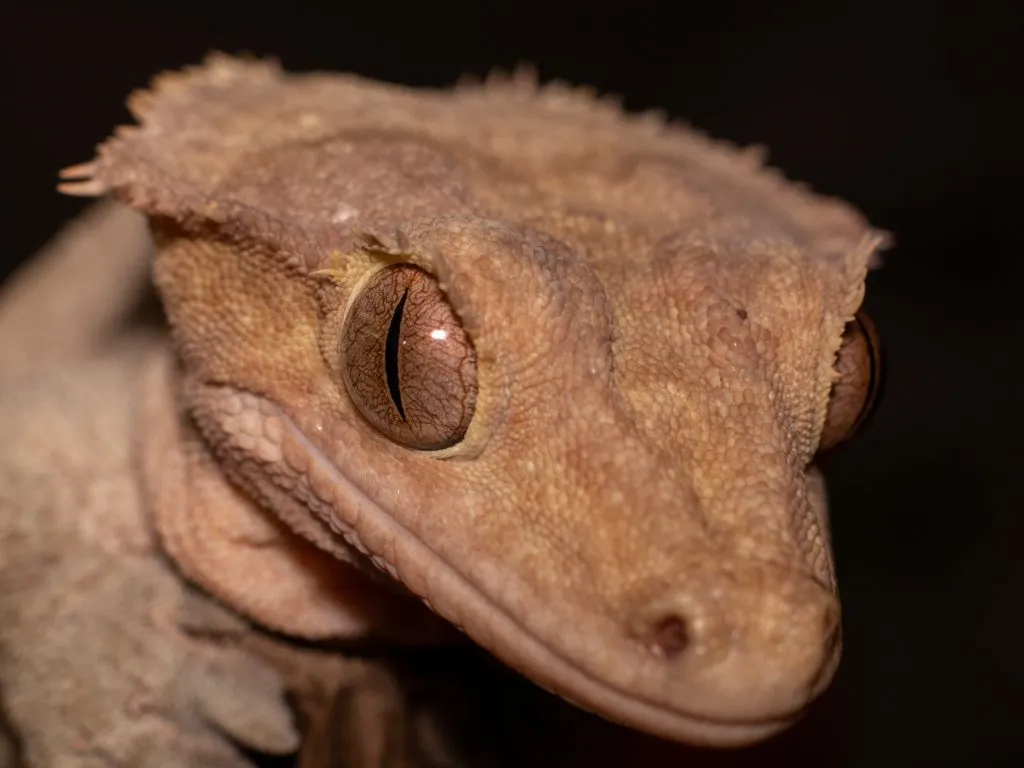
Swelling
You may notice that your crested gecko’s eyes are swollen. Additionally, the skin around the eyes might be swollen as well.
Visible Wounds or Lesions on the Eye Surface
Trauma is often accompanied by a bacterial infection. If you notice visible wounds or lesions on the eye surface, this can be a sign that your gecko suffers from an infection as well.
Lack of or Excessive Eye Licking
We’ve already established that geckos lick their eyes to clean them.
If something’s bothering them, they’ll either refrain from licking them altogether to avoid further discomfort or lick them excessively, hoping that they’ll get out whatever feels “wrong” in there.
Watch this video to see a crested gecko licking its eyes:
Rubbing or Scratching the Eyes
If your crested gecko starts rubbing or scratching its eyes (in the worst-case scenario) or the area around them, this is an alarming symptom.
Since they do not have eyelids protecting their eyes, they can harm their spectacles and further injure the eyes themselves. The problem should be addressed as quickly as possible.
Cloudy, Swollen Eyes
If you notice that your crested gecko’s eye is swollen and becomes cloudy, this is probably due to an accumulation of floods behind the spectacle.
This is often caused by infections or nasolacrimal duct blockages. In this case, you’ll have to take your reptile to the vet.
They will sedate the crested gecko and drain the fluids. If you act fast enough, the eye behind the spectacle will remain healthy. If left untreated, however, the accumulation of fluids can lead to eye removal surgery.
Watch this video to see how a veterinarian drains the fluid behind the spectacle:
Abscesses
Abscesses are enclosed infections. If you notice any lumps anywhere around your crested gecko’s eyes, you’re likely dealing with an abscess.
Most often, abscesses are caused by bacterial infections that usually affect the skin around the eye. These lumps are filled with pus where bacteria thrive – that is, if the immune system cannot fight them.
Sometimes abscesses can bulge into your gecko’s mouth as well.
However, since crested geckos have a spectacle, they can also develop subspectacular abscesses, meaning that they’re located behind the said spectacle.
Crested geckos with such abscesses should be seen by a vet because the pus that forms in there is so thick, that local or oral antibiotics will not suffice to clear it up. As such, the veterinarian may need to make an incision and remove the pus.
Uveitis
Uveitis is rarely diagnosed in reptiles, but it can sometimes be a complication of an untreated (or wrongly treated) eye infection. Moreover, it’s often linked to systemic infectious diseases that are likely the causes of eye infections as well.
Uveitis stands for intraocular inflammation and is often linked to systemic Gram-negative infections. So far, it is known for sure that Klebsiella pneumoniae caused anterior uveitis in geckos, primarily Tokay geckos.
Another study shows that a crested gecko was brought in with uveitis, which was likely caused by a traumatic event.
Apart from this, there aren’t enough scientific studies on uveitis in crested geckos and reptiles in general that would indicate how often eye infections can lead to this. Still, this illness should not be excluded before the lizard is assessed by a vet.
What Causes Eye Infections In Crested Geckos?
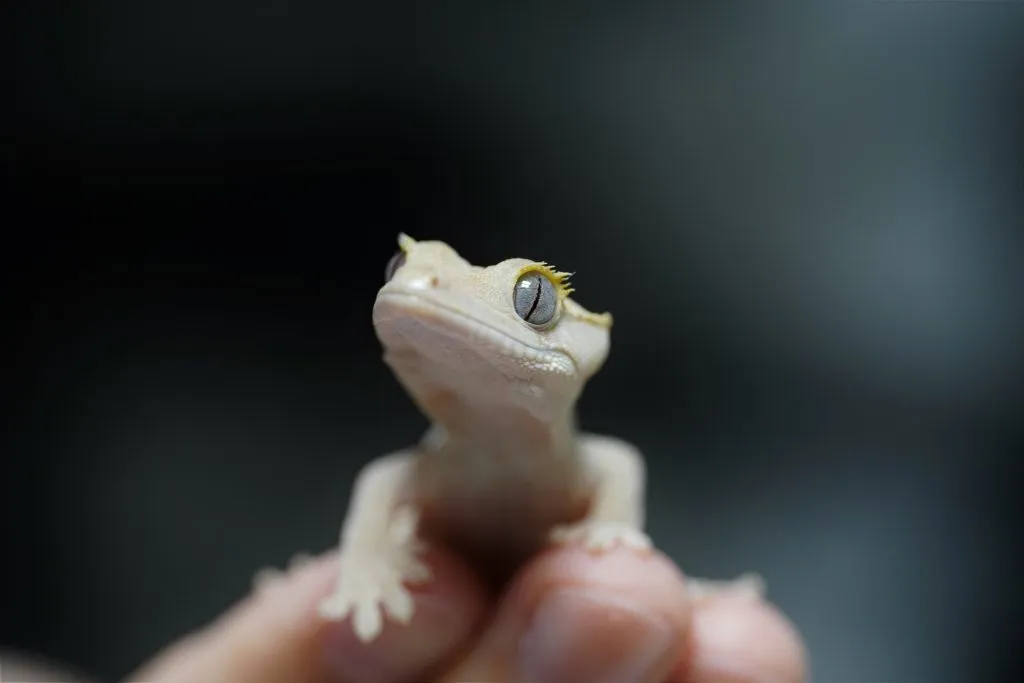
As we’ve already established, eye infections can appear as a consequence of a myriad of things. We won’t be discussing viruses and bacteria because there are too many to even start with.
Only your vet can establish what exactly the infection “consists of.”
However, we can present an overview of other common conditions in crested geckos that can manifest as or cause eye infections.
Ticks or Mite Infection
Like all beings, geckos can be infested by ticks and mites that, in turn, cause severe damage to their hosts’ overall health through hematological, biochemical, or histological changes.
If your gecko gets infected by ticks or mites, they can “settle” in your gecko’s spectacle, causing irritation and subsequent infection if not removed.
This is often seen in snakes as well, which, like crested geckos, have spectacles instead of eyelids.
To understand if this is the cause of an eye infection, you can replace the substrate in your gecko’s
Treating tick and mite infections is often done at home. However, if they get in the spectacle, it’s best to see a veterinarian to avoid damaging it and the eye itself.
Nasolacrimal Duct Blockage
We’ve already discussed the blockage of the nasolacrimal duct above, when we presented the accumulation of fluids behind the spectacle, which can happen either as a result of an infection or a blocked nasolacrimal duct.
However, there’s more to add here, mainly that a nasolacrimal duct blockage often goes hand in hand with eye infections and even other systemic infections – meaning they can either be the cause or the result of one another.
While reptiles with eyelids will exhibit symptoms of excessive ocular discharge if the nasolacrimal duct is blocked, those with spectacles will have subspectacular abscesses or accumulation of fluids.
Trauma
Naturally, trauma can lead to infections. This shouldn’t be a surprise, as that’s what happens in humans as well. When you cut yourself, you have to clean and disinfect the wound regularly until it’s healed to avoid secondary infections.
Unfortunately, your gecko may injure its eye/s without you knowing or noticing this, and, as a consequence, an eye infection may occur.
Retained Spectacle
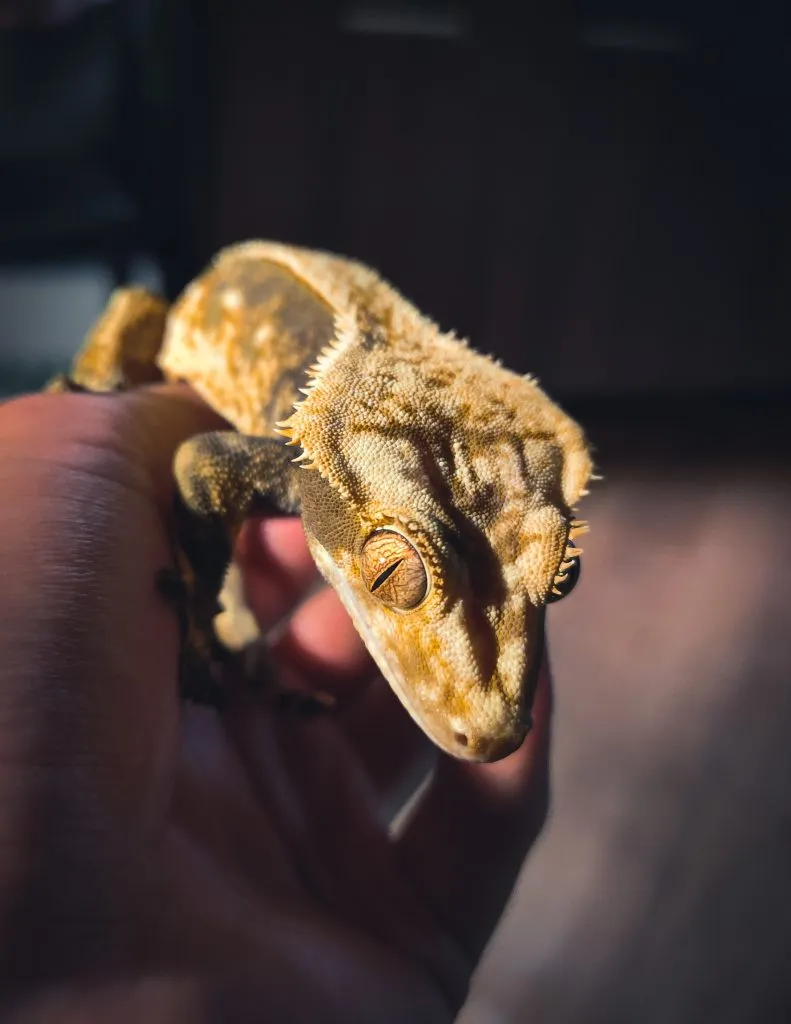
A common cause of eye problems in leopard geckos is retained shed. This is not always the case with crested geckos, however.
Although bits of skin can indeed get stuck in their eyes and cause an eye infection, a retained spectacle is most often the problem.
In short, during shedding, crested geckos shed the spectacle as well, and sometimes it just doesn’t get off.
Sometimes the retained spectacle comes off during the next shed. Other times, though, additional layers accumulate, leading to irritation and, subsequently, eye infections. Needless to say, this can also lead to vision loss and eye damage.
However, a retained spectacle can also be the result of an eye or mouth infection.
As you can see, things are not quite so easy when it comes to eye infections in crested geckos. They can either be the result or the cause of other conditions, which is why it’s best to take your pet to a vet.
Vitamin A Deficiency
Vitamin A deficiency is a common problem in geckos, as they’re insect-eating lizards.
Vitamin A is essential in normal skin cell development. As such, hypovitaminosis A is often responsible for other health issues, most commonly related to the skin, eyes (infections included), and mouth, but sometimes can even cause organ failure.
Occasionally, this problem can be treated by adjusting the diet and
Adding more insects like black fly larvae or silkworms to the diet can help supplement the body with vitamin A. Sometimes, however, a vitamin A injection might be required.
Besides, studies show that providing geckos with β-carotene supplements aids in vitamin A hepatic storage.
If there’s an eye infection caused by vitamin A, we recommend treating that first to avoid further damage to the eye, as restoring a proper vitamin A balance in the body may take time.
Specialists advise that a safe vitamin A dose for reptiles is 5000-10,000 IU/kg.
If you’re unsure what exactly you should be doing, we recommend checking with your vet, as too much vitamin A won’t do any good either. On the contrary, it will only cause further issues.
Here’s how to add vitamins to your reptile’s diet:
Foreign Body
Eye infections in reptiles are frequently caused by a foreign body – which is usually dust or substrate particles.
However, since crested geckos don’t have eyelids where dust can accumulate and frequently lick their eyes to clean them, the occurrence of eye infections caused by foreign bodies is rare.
Nevertheless, small particles may sometimes accumulate behind the spectacle if it’s improperly shed and to the ocular surface itself, thus leading to lesions and secondary infections.
Corneal Ulceration
Ulcers on the cornea are often the result of lesions or traumas and can be followed/accompanied by eye infections. This is a serious condition, and your crested gecko should be seen by a vet immediately to prevent eye removal.
Also Read: Signs Your Crested Gecko Is Dying!
How To Treat Eye Infections In Crested Geckos?
If you notice that your crested gecko shows symptoms of an eye infection, it’s best to take it to a vet as soon as possible. In the meantime, you can help your reptile by doing the following:
- Performing saline flushes
- Applying topical antibiotic ointments available without prescription
- Providing anti-inflammatory drugs
- Adjusting their diet and
tank setup - Placing them in a smaller enclosure to avoid much movement and further injuries
However, these might not be enough to treat your gecko’s condition. If you’re not sure what causes it, home treatment can sometimes make things worse.
As such, your gecko will likely require veterinary care, as it may need prescription antibiotics and/or further investigations to understand what causes the infection.
Crested vs. Leopard Gecko Eye Infections: Is There a Difference?
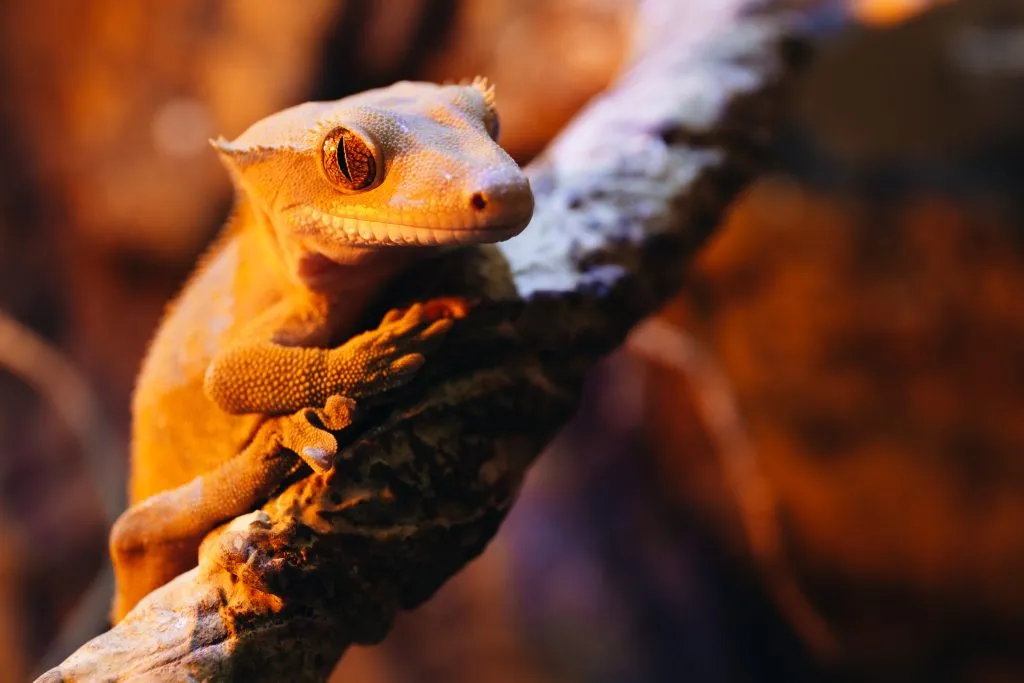
Crested gecko eye diseases aren’t as thoroughly studied as those of leopard geckos – that is, in terms of actual research based on a significant number of reptiles that would provide precise answers.
While scientists group and describe most ophthalmic diseases based on the animals’ scientific classification (lizards, amphibians, birds, etc.), there still may be slight differences between specific species.
For example, a crested gecko may develop eye conditions and symptoms (retained spectacle, subspectacular abscesses or accumulation of fluids) that leopard geckos aren’t prone to. These conditions can cause or be the result of eye infections.
Now, why are we discussing this? Because sometimes, people assume that since leopard geckos and crested geckos are both geckos, they’ll likely develop the same eye infections/disease.
This can lead to improper disease assessment, wrong home treatment, and maybe even a delayed appointment with the vet.
Crested Gecko Eye vs. Leopard Gecko Eye
Here’s a bit of context for you to get a general idea of why these two species are different.
Leopard geckos are part of the Eublepharis genus, which translates as “good eyelid,” and indicates that they have fully functional eyelids.
That’s why you’ll never see a leopard gecko licking its eyes, a common behavior noticed in many other gecko species.
Crested geckos, on the other hand, do not have functional eyelids that clean their eyes. Instead, they have something called a “spectacle.” It’s a disc-shaped scale that covers their eyes.
The spectacles keep the eyes moist but don’t clean them, which is why crested geckos use their tongues to lick the eyes.
Besides this, common leopard gecko eye infection symptoms include frequent blinking or keeping their eyes closed.
This is not applicable to crested geckos because they do not have eyelids that could blink and they never close their eyes.
No wonder people often ask themselves how crested geckos sleep with their eyes open!
Moreover, since eye infections are often indicators of other systemic diseases/infections, it would be impossible to assess what specific disease affects your crested gecko based solely on generic reptile disease information.
In short, that’s the main issue with researching the web in the hope of finding a cause for your crested gecko’s eye infection – a “highly likely” won’t always become a “100%” if your reptile isn’t checked by a vet.
That’s why we strongly recommend seeking veterinary advice if you notice an eye problem in your crested gecko. Home treatment may sometimes work, but if the problem isn’t addressed properly, it can become life-threatening.
- Enchi Ball Python: A Unique and Stunning Morph of Python regius - March 27, 2025
- Emerald Tree Monitor: The Enigmatic Green Guardian of the Rainforest - March 26, 2025
- The Egyptian Cobra (Naja haje): A Fascinating Serpent - March 25, 2025
